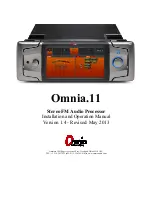
Chapter 1
DAQ System Overview
1-4
ni.com
Internal or Self-Calibration
Self-calibration is a process to adjust the device relative to a highly accurate
and stable internal reference on the device. Self-calibration is similar to the
auto-calibration or auto-zero found on some instruments. You should
perform a self-calibration whenever environmental conditions, such as
ambient temperature, change significantly. To perform self-calibration, use
the self-calibrate function or VI that is included with your driver software.
Self-calibration requires no external connections.
External Calibration
External calibration is a process to adjust the device relative to a traceable,
high precision calibration standard. The accuracy specifications of your
device change depending on how long it has been since your last external
calibration. National Instruments recommends that you calibrate your
device at least as often as the intervals listed in the accuracy specifications.
For a detailed calibration procedure for E Series devices (and B Series
devices such as the NI 6013, NI 6014, NI 6015, and NI 6016) using
NI-DAQmx, refer to the
E/S/M/B Series Calibration Procedure for
NI-DAQmx
. For a detailed calibration procedure for B/E Series devices
using Traditional NI-DAQ (Legacy), refer to the
E Series Calibration
Procedure
. These documents can be found by selecting
Manual
Calibration Procedures
at
ni.com/calibration
.
Signal Conditioning
Many sensors and transducers require signal conditioning before a
computer-based measurement system can effectively and accurately
acquire the signal. The front-end signal conditioning system can include
functions such as signal amplification, attenuation, filtering, electrical
isolation, simultaneous sampling, and multiplexing. In addition, many
transducers require excitation currents or voltages, bridge completion,
linearization, or high amplification for proper and accurate operation.
Therefore, most computer-based measurement systems include some form
of signal conditioning in addition to plug-in data acquisition DAQ devices.
Sensors and Transducers
Sensors can generate electrical signals to measure physical phenomena,
such as temperature, force, sound, or light. Some commonly used sensors
are strain gauges, thermocouples, thermistors, angular encoders, linear
encoders, and resistance temperature detectors (RTDs).
Содержание PCI-6034E
Страница 1: ...PCI 6034E...
Страница 2: ...DAQ E Series E Series User Manual E Series User Manual February 2007 370503K 01...
















































